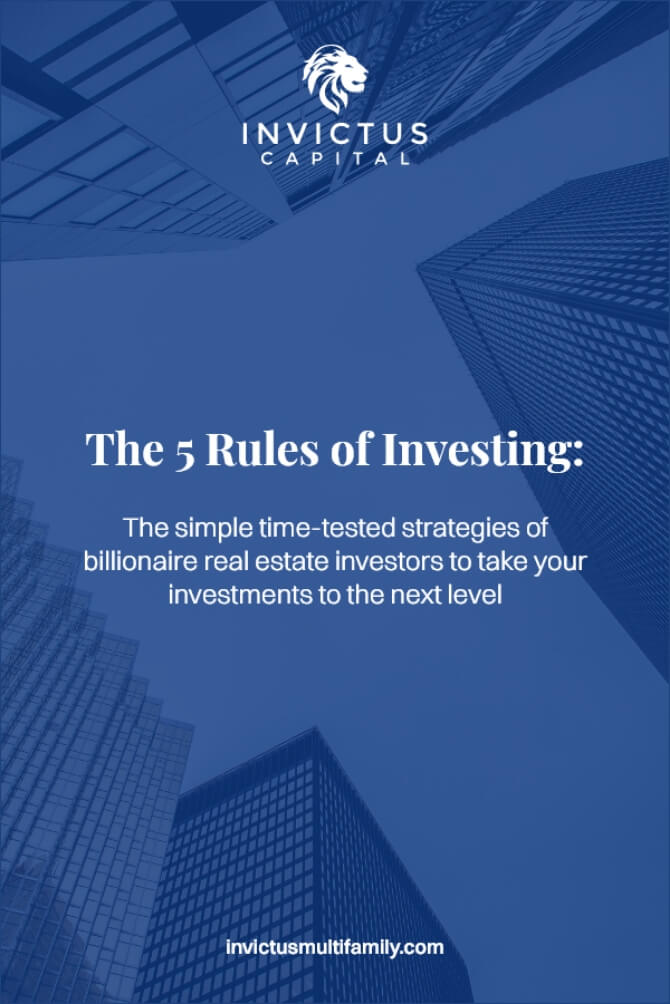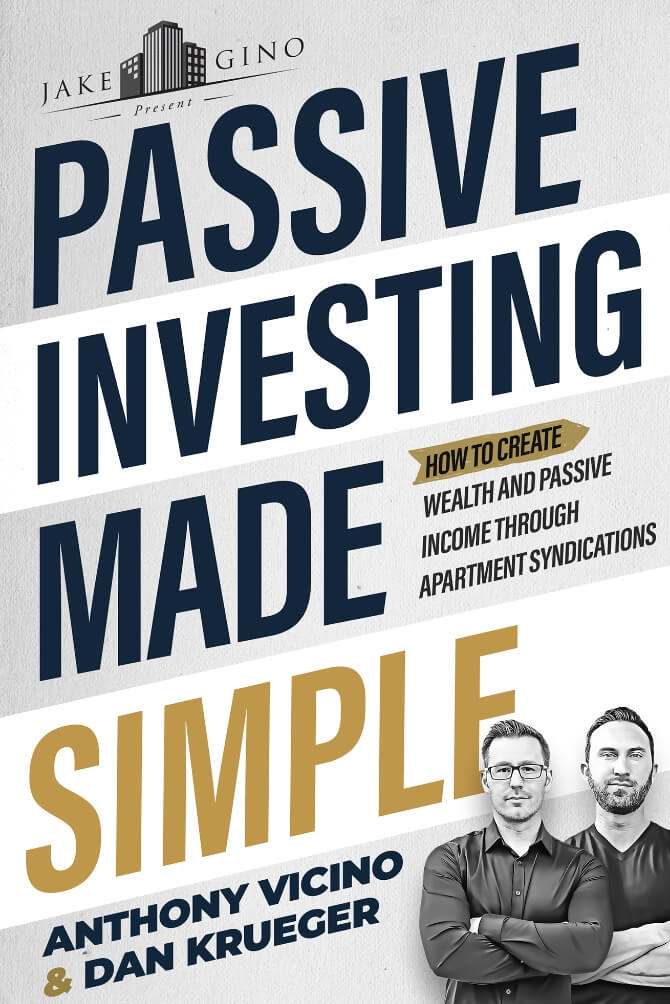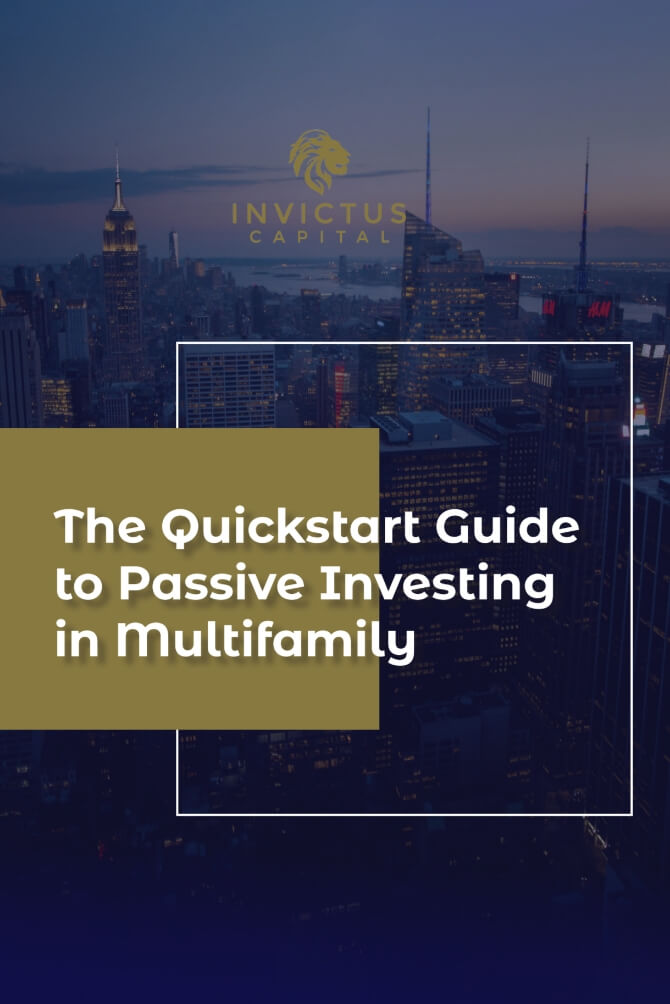For today’s episode, we will be discussing how much you stand to make in apartment syndications.
This week we’re covering what type of returns you can make as a real estate investor.
We will talk about these things…and more in another episode of Multifamily Investing Made Simple in under 10 minutes.
Tweetable Quotes:
“my answer to people now is to pay your expectations somewhere in the mid-20s, average annual return, there’s going to be deals that do better than that. There are going to be deals that don’t quite get that.” – Dan Kreuger
“whether you’re looking at value add C class multifamily like we do or class A, you’re getting returns either better or twice as good with a risk profile comparable to the government bonds” – Anthony Vicino
“I think twenty to twenty-five percent IRR is pretty common in the types of deals that we do.” – Anthony Vicino
“we like good quality buildings that are good neighborhoods that are producing cash flow from day one and there’s upside potential” – Dan Kreuger
LEAVE A REVIEW if you liked this episode!!
Keep up with the podcast! Follow us on Apple, Stitcher, Google, and other podcast streaming platforms.
To learn more, visit us at https://invictusmultifamily.com/
**Want to learn more about investing with us?**
We’d love to learn more about you and your investment goals. Please fill out this form and let’s schedule a call: https://invictusmultifamily.com/contact/
**Let’s Connect On Social Media!**
LinkedIn: https://www.linkedin.com/company/11681388/admin/
Facebook: https://www.facebook.com/invictuscapitalventures/
YouTube: https://bit.ly/2Lc0ctX

What Types of Returns Can You Expect In an Apartment Syndication
Anthony Vicino : [00:00:14] Hello and welcome to Multifamily Investing, made the podcast that’s all about taking the complexity out of real estate investing so that you can take action to date. I am your host, Anthony Vesnina of Invictus Capital, and I hope you have enjoyed my narrator’s voice. I’m joined as always by Dan. Look at him out there in the wild Kruger in his natural habitat of the Invictus headquarters downtown Minneapolis.
Dan Krueger: [00:00:39] Do you like an NPR episode where we always with nice and
Anthony Vicino : [00:00:44] Calm, nice, and quiet. OK, so today I’m going to be I’m going to try and keep this up, this out. So we’re going to lose so many ways all the time. So so if you have not left us yet, you have stayed this long. Well, plus, bless your beautiful heart. We appreciate you. So today, let’s talk about 30 minutes, and let’s talk about one of the questions a lot of people have when they come to real estate investing is how much do you really stand to make? Like what are the returns look like? Because we talk about all the time, like real estate, great returns by comparison to a lot of other investment vehicles. But what does that really mean when we say great returns? And just to preface this. It depends. It’s a bit of a moving target, so we’re going to try and layout the groundwork, depending on your investor profile, different types of assets. So let’s break this down. Down what type of returns can I expect as a real estate investor?
Dan Krueger: [00:01:43] Should we just go to a lawyer and say, it depends? Yeah, just take that just real information, no insight.
Anthony Vicino : [00:01:49] Our lawyers bless their beautiful lawyer hearts. They give us no info ever.
Dan Krueger: [00:01:55] You know, listen to our podcast. Do they?
Anthony Vicino : [00:01:58] Actually, Zach, if you’re listening to this.
Dan Krueger: [00:02:00] We love you. That I know you guys that you guys are just lawyers, but not on top of what we’re talking about today is like how much money you make in real estate. So that’s a really common question. We talk to a lot of investors and they’re all curious about who we are. We do on a track record as risk is. But really the big question that everyone shows up for that meeting call, phone call, or whatever it is, how much money can I make here? And then they want to know what am I going to think? The answer is one million dollars
Anthony Vicino : [00:02:33] And one million.
Dan Krueger: [00:02:34] That’s I think today’s we’re just going to talk about basically to talk about our model first and foremost because we could provide the best kind of data on what we do with those various different asset classes as various different deals out there with different risk profiles. But we’re going to be talking about B minus C plus asset class that qualifies as value value-add, not necessarily distressed properties, not war zone properties, but we like good quality buildings that are good neighborhoods that are producing cash flow from day one and there’s upside potential. So there’s a value that. So I think that is a really popular beach to be in. So I think this episode should provide some clarity to the return profile for that asset class, and that should help a lot of people. But there are a few different ways to look at the returns in real estate. And we are going to wrap this up with just a really basic number. We want to just also let you know that there are a few different ways to make money. These deals, right? Your cash flow on monthly basis. If you’re doing deals like us, we’ve got to refinance built in there. So that big deal sometime in the middle there. There’s a capital that’s where there’s cash that gets there’s equity that gets pulled out of the property distributed to investors. Everyone keeps their same ownership percentage. But let’s then take that capital. We load it to the next deal or buy a Ferrari if they want. And then you’ve got the sale at the proceeds at the end. So really, I think what people are asking, what’s the what am I going to make that kind of a no, just the aggregate start to finish. All those different components include tax. That’s another conversation. But from start to finish, like how much would I make on average in a year or over a whole period of. So what’s the number, the answer is,
Anthony Vicino : [00:04:27] So what is it, Dad?
Dan Krueger: [00:04:29] I’ve actually got really good at bailing this out because I’ve always just provided a ton of data, said, OK, here are some examples of everything that’s happened. It’s just OK, they don’t want all of that on average. And so my my my answer to people now is to pay your expectations somewhere in the mid-20s, average annual return, there’s going to be deals that do better than that. There are going to be deals that don’t quite get that. But from start to finish, just the aggregate average annual return, not going to do the IRR thing. It’s not that different. That’s kind of what you’re looking at getting from a pretty good deal. When we present our deals, we usually present the worst-case scenario. Well, not the worst worst-case scenario, but we present a pretty pessimistic scenario when we put our deals together because we want to make sure that they could weather an economic storm. But that said, we know how these things actually turn out, how they have turned out and how much cash we have in our projections. And so mid-twenties, I think, is a really good spot to take your expectations for the types of deals that we do.
Anthony Vicino : [00:05:34] So let’s compare this with a couple of minutes that we have left on the show. Let’s compare this and contrast it with what you might expect from a bond or stock market or say like class syndication. So something that’s a little bit more stabilized, not value baked into it in the same way that we do. I think twenty to twenty-five percent IRR is pretty common in the types of deals that we do. But, you know, certainly, there’s other. Other avenues that you can make money, so it’s helpful to compare it against some of the most likely alternatives
Dan Krueger: [00:06:11] Treasury has pulled up here if you
Anthony Vicino : [00:06:12] Hit me with it, what can I get from the Treasury?
Dan Krueger: [00:06:16] Well, they’re really small numbers. So like 10 percent. I guess if we look at our types of deals and we’re looking at seven to 10 year, five or seven-year deals, which probably looking at five to seven-year term bonds to at least get something reasonable. So right now, five years Treasury bill point sixteen point eight percent,
Anthony Vicino : [00:06:40] The NASDAQ is up to four. And this is an interesting point that I want to draw here is that Thomson Reuters, the 20-year longitudinal study from 1993 to 2013, studied seven different asset classes. And in there they rank them across risk and return axes. And what they found was that commercial real estate. What we’re talking about is a type that had a risk profile similar to bonds, which I found really interesting. So you could go and get
Dan Krueger: [00:07:09] Bets as they have on there, which
Anthony Vicino : [00:07:11] Are they also have corporate, which is a little bit higher, but to a corporate or so a government fund, which is one of the lowest risk vehicles that people commonly think about. So commercial real estate has a risk profile similar to a government bond. But what is I can’t even do the math on that. It’s like a 40, 40. The return then the government bond like that’s not even in the same ballpark. So let’s go to the other side and we’re going to talk. Let’s go to the other side of that graph that we just talked about, the low risk, low return side. And we found, OK, commercial real estate, they’re low risk. Now, let’s look at the high return, high-risk side. And that’s where we found large-cap stocks.
Dan Krueger: [00:07:52] So what’s with the highest return? Oh, was it. Oh, really? Yeah. Midcaps, because large caps or smaller.
Anthony Vicino : [00:07:58] That’s right. In the small-cap where
Dan Krueger: [00:07:59] The caps had a higher risk profile. Yeah.
Anthony Vicino : [00:08:03] So what kind of returns do you remember that they were hitting.
Dan Krueger: [00:08:06] I don’t remember the number of that graph, but I would guess it’s going to be slightly above that average S&P number that people gave, which is like 10 or 11 percent. So, I mean, the S&P is midcaps, Russel’s midcaps. So I would say add a few points to that. But there’s also your standard deviation, be more volatile, hence the increased risk. So I’d say we could be generous and say 13, 14 percent pre-tax returns with the risk profile significantly higher. So you get the returns that are better than the highest asset class the tops are looking at and the return or the risk profile of the safest thing on there, which is corporate bonds.
Anthony Vicino : [00:08:53] So no matter how you slice it, the returns that we’re seeing on these types of value add syndications, these private placements, they’re almost double the returns that you would see on the stock market. But with the risk profile of a government bond
Dan Krueger: [00:09:08] With a stabilized class, what have you seen? I would I would
Anthony Vicino : [00:09:13] Say like 12 to 14 percent would
Dan Krueger: [00:09:15] Be generous
Anthony Vicino : [00:09:17] That would be my expectation of like. Yeah, but even then, they’re still generating returns equal to the stock market. And that’s a really stable, safe choice where there’s not a lot of meat on the bones. Theoretically, it’s not going up because it’s brand new. It’s as valuable as it’s ever going to be. So no matter how you really cut it, whether you’re looking at value add see class multifamily like we do or class, you’re getting returns either better or twice as good with a risk profile comparable to the government bonds. It’s like I don’t know when you start to get that picture, that profile, it’s like, wow, this is really crazy that more people don’t do this.
Dan Krueger: [00:09:52] Yeah. And I think that’s a factor in coming up close to the end of the year. But the one other nuance is that the returns aside like that, the tax situation is going to be the one that really moves the needle for a lot of people. As you get wealthier and as you have higher incomes, it’s going to be a bigger and bigger factor for you. So if you are in that place where you’re really looking at how can I reduce my tax liability, yet at some point you will be. And that’s usually just the cherry up top for people. The returns are great. But the fact that you actually get to keep significantly more of those returns relative to anything else other than the way down drilling for oil is usually what’s what makes this kind of a landslide asset class for a lot of people? Absolutely.
Anthony Vicino : [00:10:40] That’s what you can expect in terms of returns. I don’t know like we’re just talking ballparks like that. Past performance is not a guarantee of future performance. I don’t take what we’re saying and be like they said, twenty-five percent IRR. So that’s what I should get. But I’m just trying to ballpark it for you guys at home that you have an expectation and realize like we’re not talking about real estate just being a little bit better than the stock market. And the bond alternative, we’re talking about it being a lot better, so hopefully, it was informative. If you’re interested in learning more about investing in these vehicles but you don’t want to do any other work, well, go pick up the book. Passive investing is made simple. It’s on Amazon. It’s awesome. It’s going to help you learn more about how awesome this vehicle is. So I don’t know. That’s my shameless plug. We appreciate you guys make sure to go over to iTunes that you subscribe to. Hit the bell. You leave a review. I, I don’t know, hit all the buttons over there. And we’ll look forward to seeing you guys next week.


